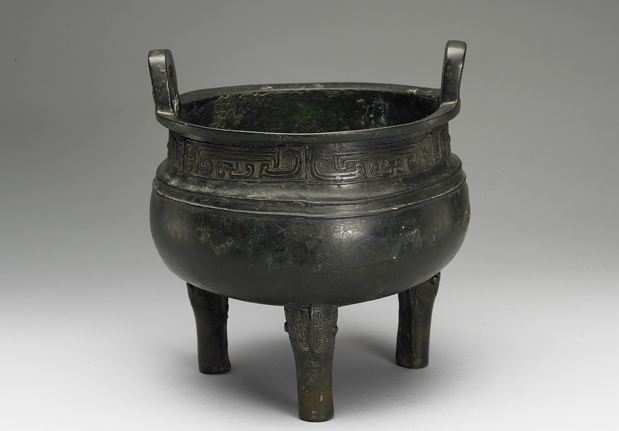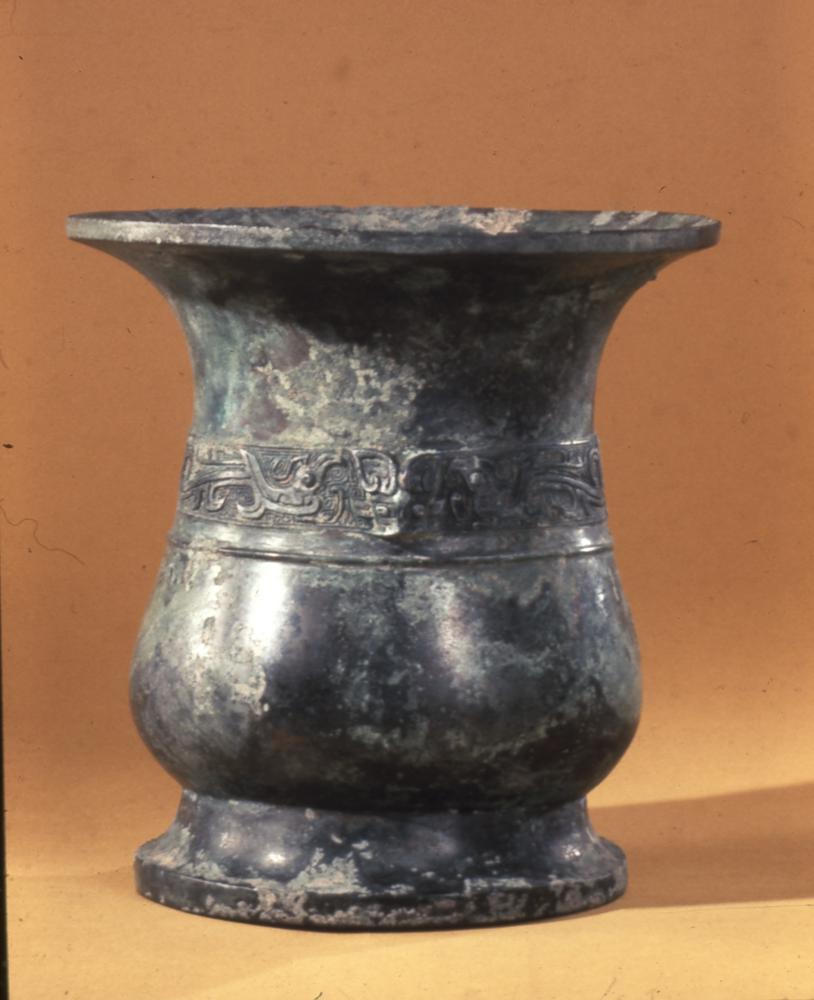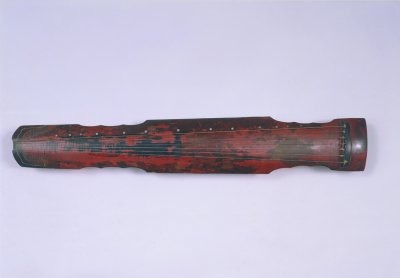Period:Shang dynasty Production date:15thC BC-14thC BC (circa)
Materials:bronze
Technique:
Subjects:taotie
Dimensions:Height: 14.63 centimetres Length: 13.50 centimetres (at spout)
Description:
Bronze vessel of the type called jue. The vessel has a short spout with two posts at its corners, an oval body with a handle attached to it and a slightly flared skirt above three short legs. The piece-mould casting process made joints necessary whose marks can be seen down the centre of each leg and along the corresponding parts of the body. On one side of the vessel is a simple taotie face. Two shorter sections, bisected by a handle, are on the other side. They contain abstract flourishes in thread relief.
IMG
![图片[1]-jue BM-1960-1014.1-China Archive](https://chinaarchive.net/Shang dynasty/Bronzes/mid_00201984_001.jpg)
![图片[2]-jue BM-1960-1014.1-China Archive](https://chinaarchive.net/Shang dynasty/Bronzes/mid_00308036_001.jpg)
![图片[3]-jue BM-1960-1014.1-China Archive](https://chinaarchive.net/Shang dynasty/Bronzes/mid_00513859_001.jpg)
![图片[4]-jue BM-1960-1014.1-China Archive](https://chinaarchive.net/Shang dynasty/Bronzes/mid_00758462_001.jpg)
![图片[5]-jue BM-1960-1014.1-China Archive](https://chinaarchive.net/Shang dynasty/Bronzes/mid_00758463_001.jpg)
![图片[6]-jue BM-1960-1014.1-China Archive](https://chinaarchive.net/Shang dynasty/Bronzes/mid_00760566_001.jpg)
Comments:Rawson 1987:Jue are the earliest-surviving bronze vessels. Many have been found at Erlitou-period sites. They have long spouts, narrow waists and slender slightly splayed legs. This neat jue is more restrained in proportion, with a short spout, an oval body and a slightly flared skirt above three short slight legs, features typical of the Erligang period.All surviving jue were cast in piece-moulds, whose joints left marks down the centre of each leg and along the corresponding parts of the body. Two posts at the corners of the spout and rim and curved handles are standard in this vessel type. The posts are elementary, being little more than small vertical extensions with flattened tops; their function has been much debated – it is possible that they are simply the rennants of sprues. However, as all other extraneous traces of the casting process have been smoothed away, this view does not seem entirely plausible.An early feature is the slight ridge of bronze inside the lip. Again there is no agreement as to its purpose. It has been argued that it imitates a folded lip on a wrought bronze vessel. These views have been hotly contested, but alternative suggestions are no more plausible.On one side of the vessel is a simple taotie face in Style II, while two shorter sections on the other side, bisected by a handle, contain abstract flourishes in thread relief designated as Style I. In due course such abstract motifs were given eyes and so could be interpreted as some sort of creature in profile. Rawson 1992:Early bronze vessels, such as this, are often relatively small and thinly cast. They gradually replaced the ceramic vessels previously buried in tombs. While almost all bronze vessel shapes were based on Neolithic ceramics, the source of the earliest type of all, the ‘jue’, is something of a mistery. It has a narrow spout, a sharply angled body and small posts on the lip. The ‘jue’ survived in this shape for two thousands years but the question of where did it come from remains unanswered.
Materials:bronze
Technique:
Subjects:taotie
Dimensions:Height: 14.63 centimetres Length: 13.50 centimetres (at spout)
Description:
Bronze vessel of the type called jue. The vessel has a short spout with two posts at its corners, an oval body with a handle attached to it and a slightly flared skirt above three short legs. The piece-mould casting process made joints necessary whose marks can be seen down the centre of each leg and along the corresponding parts of the body. On one side of the vessel is a simple taotie face. Two shorter sections, bisected by a handle, are on the other side. They contain abstract flourishes in thread relief.
IMG
![图片[1]-jue BM-1960-1014.1-China Archive](https://chinaarchive.net/Shang dynasty/Bronzes/mid_00201984_001.jpg)
![图片[2]-jue BM-1960-1014.1-China Archive](https://chinaarchive.net/Shang dynasty/Bronzes/mid_00308036_001.jpg)
![图片[3]-jue BM-1960-1014.1-China Archive](https://chinaarchive.net/Shang dynasty/Bronzes/mid_00513859_001.jpg)
![图片[4]-jue BM-1960-1014.1-China Archive](https://chinaarchive.net/Shang dynasty/Bronzes/mid_00758462_001.jpg)
![图片[5]-jue BM-1960-1014.1-China Archive](https://chinaarchive.net/Shang dynasty/Bronzes/mid_00758463_001.jpg)
![图片[6]-jue BM-1960-1014.1-China Archive](https://chinaarchive.net/Shang dynasty/Bronzes/mid_00760566_001.jpg)
Comments:Rawson 1987:Jue are the earliest-surviving bronze vessels. Many have been found at Erlitou-period sites. They have long spouts, narrow waists and slender slightly splayed legs. This neat jue is more restrained in proportion, with a short spout, an oval body and a slightly flared skirt above three short slight legs, features typical of the Erligang period.All surviving jue were cast in piece-moulds, whose joints left marks down the centre of each leg and along the corresponding parts of the body. Two posts at the corners of the spout and rim and curved handles are standard in this vessel type. The posts are elementary, being little more than small vertical extensions with flattened tops; their function has been much debated – it is possible that they are simply the rennants of sprues. However, as all other extraneous traces of the casting process have been smoothed away, this view does not seem entirely plausible.An early feature is the slight ridge of bronze inside the lip. Again there is no agreement as to its purpose. It has been argued that it imitates a folded lip on a wrought bronze vessel. These views have been hotly contested, but alternative suggestions are no more plausible.On one side of the vessel is a simple taotie face in Style II, while two shorter sections on the other side, bisected by a handle, contain abstract flourishes in thread relief designated as Style I. In due course such abstract motifs were given eyes and so could be interpreted as some sort of creature in profile. Rawson 1992:Early bronze vessels, such as this, are often relatively small and thinly cast. They gradually replaced the ceramic vessels previously buried in tombs. While almost all bronze vessel shapes were based on Neolithic ceramics, the source of the earliest type of all, the ‘jue’, is something of a mistery. It has a narrow spout, a sharply angled body and small posts on the lip. The ‘jue’ survived in this shape for two thousands years but the question of where did it come from remains unanswered.
© Copyright
The copyright of the article belongs to the author, please keep the original link for reprinting.
THE END





